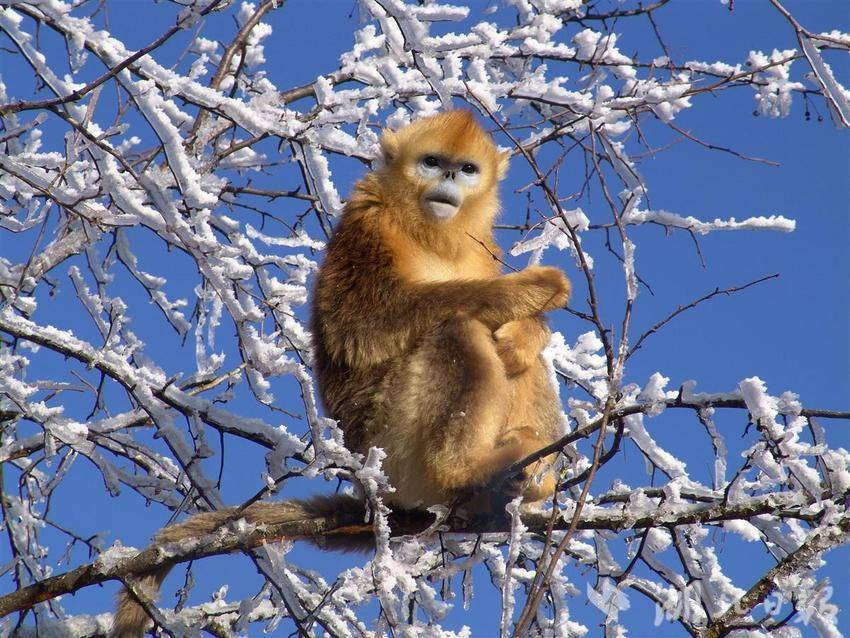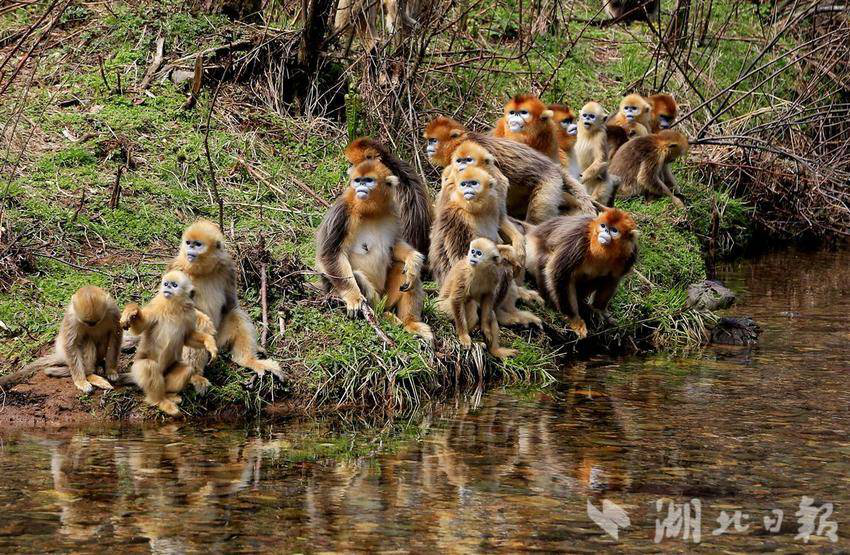Population of Golden Snub-nosed Monkeys in Shennongjia Confirmed at 1,618 Across 11 Groups
Updated:2024-07-03 Source:Hubei Daily
Hubei Daily (Reporter Liu Hanze, Correspondents Du Hua, Wang Pin) – On June 29, a press conference announcing the results of the latest population survey of the Shennongjia golden snub-nosed monkeys revealed that, after more than two months of research, scientists have confirmed there are 11 groups of golden snub-nosed monkeys in Shennongjia, totaling 1,618 individuals. This marks an approximate 10% increase since 2019. The habitat area now spans 401 square kilometers, up by about 13%.
In 1990, there were only 501 golden snub-nosed monkeys in Shennongjia
Golden snub-nosed monkeys are classified as a first-class protected wild animal in China. Among the golden snub-nosed monkey family, the Shennongjia population is the smallest and most endangered isolated group.
In 1978, scientists collected two golden snub-nosed monkey specimens while investigating "wildmen" in Shennongjia. The academic community discovered the presence of these monkeys in 1979. Liu Minzhuang from East China Normal University first reported their distribution in 1980.
Surveys show that in 1990, Shennongjia had five groups of golden snub-nosed monkeys, totaling 501 individuals, with a habitat area of 164 square kilometers. By 2005, this increased to eight groups and 1,282 individuals, covering 189 square kilometers. In 2019, the numbers were 10 groups and 1,471 individuals, with a habitat area of 354 square kilometers.


Comprehensive survey covers 58,800 kilometers
Since 2019, no comprehensive survey of the golden snub-nosed monkey population in Shennongjia had been conducted. Questions about whether the population had continued to grow and whether their habitat had changed remained unanswered.
The recent survey involved over 40 researchers conducting field investigations and laboratory analyses over more than two months. A total of 840 person-trips were made for the fieldwork, covering 240 survey routes and 58,800 kilometers.
The findings indicate that there are now 11 groups of golden snub-nosed monkeys, totaling 1,618 individuals, with a habitat area of 401 square kilometers. Compared to 1990, this represents an increase of six groups (83%), 1,117 individuals (223%), and 237 square kilometers of habitat area (145%). Since 2019, there has been an increase of one group, 147 individuals, and 47 square kilometers of habitat area.

New technologies ensure accurate data
The fourth survey of golden snub-nosed monkeys employed new technologies, including infrared sensing drones for counting, genetic diversity and individual identification techniques based on molecular resolution, and food analysis using metagenomic technology. It also utilized habitat analysis with high-definition remote sensing data and established a human disturbance monitoring system with infrared cameras, trap cameras, and self-organizing network technology.
Infrared sensing for counting
Due to the high mobility of golden snub-nosed monkeys, accurately counting them in the wild was challenging. Now, infrared sensing drones take aerial photographs to precisely count the monkeys.

DNA technology for population identification
Researchers collected fecal samples from golden snub-nosed monkeys, extracting DNA from intestinal wall cells to perform individual identification and genetic diversity analysis, ensuring accurate data by resolving issues of repeated counting.

Genetic technology for food analysis
By extracting, amplifying, and sequencing metagenomes from monkey feces, researchers identified over 140 plant species, gaining insights into the dietary preferences of different monkey groups and analyzing the quality of their habitats. This data will help researchers evaluate ecological carrying capacity and provide guidance for habitat restoration.
Remote sensing for habitat identification
Using high-resolution remote sensing images, researchers identified habitats and established a spectral feature database of typical habitat elements. This enabled the identification of plant community distribution across seasons and provided key technical support for accurately identifying the optimal habitats, creating optimal habitat distribution models and analyzing potential habitat areas.
Continued improvement of Shennongjia's ecological environment
Li Diqiang, Chief Expert at the Institute of Forest Ecology, Environment, and Nature Conservation, Chinese Academy of Forestry, noted the steady increase in the golden snub-nosed monkey population and habitat area in Shennongjia indicates significant ecological improvement and progress in conservation and research.
Shennongjia is globally recognized for its rich biodiversity and serves as a species gene pool, being one of the 34 global biodiversity hotspots. Its ecological value is of global significance, with distinct, representative, and rare characteristics.
In recent years, Shennongjia has strictly implemented the "three types and five levels" zoning control rules and a negative list management approach, maintaining biodiversity security, establishing 60 forest dynamic monitoring plots, nurturing 24,000 mu of forests, restoring 297,000 mu of degraded forests, and closing off 1.0286 million mu of mountains for forest cultivation. Forest coverage has remained stable at 91.12%, and the ecological environment quality continues to improve. Copyright Shennongjia National Park
Address:36 Chulin Road, Muyu Town, Shennongjia Forestry District, Hubei Province 鄂ICP备18005077号-3
Address:36 Chulin Road, Muyu Town, Shennongjia Forestry District, Hubei Province 鄂ICP备18005077号-3
Email:2673990569@qq.com
Phone:0719-3453368
Phone:0719-3453368


TOP

